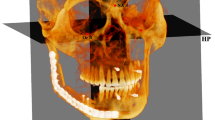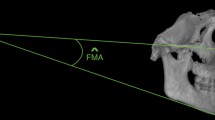Abstract
Objectives:
This study analyzes the condylar position with intercondylar distance and angle after sagittal split osteotomy in mono- and bimaxillary orthognathic surgery applying cone-beam computed tomography (CBCT) images before and after surgery.
Materials and Methods:
Data of 18 patients, ten males (mean age 28 years) and eight females (mean age 26 years) undergoing the described surgery between 2008 and 2009 were analyzed. CBCT scans were performed with the KaVo 3DeXam (KaVo, Biberach/ Riß, Germany) (identical with the iCAT scan device) before and after surgery. The exported DICOM data were analyzed with ImageJ morphometry software. Patients were also asked about TMJ problems. The two-tailed t test was used and significance was set at a p value less than p = 0.05.
Results:
There was no significant difference between the pre- and postoperative distances between condylar centers (mean difference: 1 mm) (p = 0.69) and intercondylar angle (mean difference: 6.6°) (p = 0.27).
Conclusions:
CBCT is a novel imaging technique appropriate for detailed and three-dimensional analysis of the condylar position in orthognathic surgery. Available freeware analysis software can be applied for metrical measurements. Our cases showed no significant changes of condylar position immediately after surgery without intraoperative condylar fixation.
Zusammenfassung
Ziel:
Diese Studie analysiert anhand von DVT-Bildern die Kondylenposition mit interkondylärer Distanz und axialem Winkel der Kondylenwalzen zueinander vor und nach der sagittalen Unterkieferosteotomie im Rahmen uni- und bimaxillärer dysgnathiechirurgischer Eingriffe.
Material und Methodik:
Die Datenanalyse erfolgte bei 18 Patienten, zehn männlich (Durchschnittsalter 28 Jahre) und acht weiblich (Durchschnittsalter 26 Jahre), bei denen zwischen 2008 und 2009 eine entsprechende Umstellungsosteotomie durchgeführt wurde. Die DVT-Untersuchungen erfolgten prä- und postoperativ mit dem KaVo 3DeXam (KaVo, Biberach/Riß, Deutschland) (identisch mit dem iCAT-Scan-Gerät). Die exportierten DICOM-Daten wurden mit der "ImageJ"-Bildanalyse-Software untersucht. Patienten wurden zusätzlich zu Kiefergelenkbeschwerden befragt. Die statistische Analyse erfolgte mittels zweiseitigem t-Test, wobei ein p-Wert kleiner als p = 0,05 als signifikant angesehen wurde.
Ergebnisse:
Zwischen den prä- und postoperativen Werten bestand kein signifikanter Unterschied für die Distanz der Kondylenzentren (Durchschnitt: 1 mm) (p = 0,69) und dem axialen Interkondylarwinkel (Durchschnitt: 6,6°) (p = 0,27).
Schlussfolgerungen:
Das DVT ist eine neuartige Bildgebungsmethode, die zur detaillierten 3D-Analyse der Kondylenposition in der Dysgnathiechirurgie geeignet ist. Verfügbare kostenlose Analyse-Software kann zur Vermessung verwendet werden. Unsere Fälle zeigen unmittelbar nach dem Eingriff ohne intraoperative Kondylenfixation keine signifikanten Veränderungen in der Kondylenposition.
Similar content being viewed by others
References
Abrahamsson C, Ekberg E, Henrikson T, Bondemark L. Alterations of temporomandibular disorders before and after orthognathic surgery: a systematic review. Angle Orthod 2007;77:729–34.
Abrahamsson C, Ekberg E, Henrikson T, et al. TMD in consecutive patients referred for orthognathic surgery. Angle Orthod 2009;79:621–7.
Al-Riyami S, Moles DR, Cunningham SJ. Orthognathic treatment and temporomandibular disorders: a systematic review. Part 1. A new quality-assessment technique and analysis of study characteristics and classifications. Am J Orthod Dentofacial Orthop 2009;136:624 e1-15; discussion 624-5.
Bell FA, 3rd, Small EW. Inexpensive osteotomes for orthognathic surgery. J Oral Surg 1975;33:545.
Boyne PJ. Osseous healing after oblique osteotomy of the mandibular ramus. J Oral Surg 1966;24:125–33.
Cascone P, Di Paolo C, Leonardi R, Pedulla E. Temporomandibular disorders and orthognathic surgery. J Craniofac Surg 2008;19:687–92.
Cevidanes LH, Bailey LJ, Tucker GR Jr, et al. Superimposition of 3D cone-beam CT models of orthognathic surgery patients. Dentomaxillofac Radiol 2005;34:369–75.
Champy M, Lodde JP, Schmitt R, et al. Mandibular osteosynthesis by miniature screwed plates via a buccal approach. J Maxillofac Surg 1978;6:14–21.
Chidiac JJ, Shofer FS, Al-Kutoub A, et al. Comparison of CT scanograms and cephalometric radiographs in craniofacial imaging. Orthod Craniofac Res 2002;5:104–13.
Coppenrath E, Draenert F, Lechel U, et al. Cross-sectional imaging in dentomaxillofacial diagnostics: dose comparison of dental MSCT and NewTom 9000 DVT. Rofo 2008;180:396–401.
de Oliveira AE, Cevidanes LH, Phillips C, et al. Observer reliability of three-dimensional cephalometric landmark identification on conebeam computerized tomography. Oral Surg Oral Med Oral Pathol Oral Radiol Endod 2009;107:256–65.
Dervis E, Tuncer E. Long-term evaluations of temporomandibular disorders in patients undergoing orthognathic surgery compared with a control group. Oral surgery, oral medicine, oral pathology, oral radiology, and endodontics 2002;94:554–60.
Eckerdal O, Sund G, Astrand P. Skeletal remodelling in the temporomandibular joint after oblique sliding osteotomy of the mandibular rami. Int J Oral Maxillofac Surg 1986;5:233–9.
Edlund J, Hansson T, Petersson A, Willmar K. Sagittal splitting of the mandibular ramus. Electromyography and radiologic follow-up study of temporomandibular joint function in 44 patients. Scand J Plast Reconstr Surg 1979;13:437–43.
Ellis E, 3rd. Condylar positioning devices for orthognathic surgery: are they necessary? J Oral Maxillofac Surg 1994;52:536–52; discussion 552-34.
Epker BN. Modifications in the sagittal osteotomy of the mandible. J Oral Surg 1977;35:157–9.
Epker BN, Bronson J. Surgical-prosthetic correction of dentofacial deformities. J Am Dent Assoc 1978;97:184–92.
Fang B, Shen GF, Yang C, et al. Changes in condylar and joint disc positions after bilateral sagittal split ramus osteotomy for correction of mandibular prognathism. Int J Oral Maxillofac Surg 2009;38:726–30.
Farella M, Michelotti A, Bocchino T, et al. Effects of orthognathic surgery for class III malocclusion on signs and symptoms of temporomandibular disorders and on pressure pain thresholds of the jaw muscles. Int J Oral Maxillofac Surg 2007;36:583–7.
Fernandez Sanroman J, Gomez Gonzalez JM, Alonso Del Hoyo J, Monje Gil F. Morphometric and morphological changes in the temporomandibular joint after orthognathic surgery: a magnetic resonance imaging and computed tomography prospective study. J Craniomaxillofac Surg 1997;25:139–48.
Freihofer HP, Jr. Modellversuch zur Lageveränderung des Kieferköpfchens nach sagittaler Spaltung des Unterkiefers. Schweiz Monatsschr Zahnheilkd 1977;87:12–22.
Frey DR, Hatch JP, Van Sickels JE, et al. Effects of surgical mandibular advancement and rotation on signs and symptoms of temporomandibular disorder: a 2-year follow-up study. Am J Orthod Dentofacial Orthop 2008; 133:490 e491-8.
Hirschfelder U. Die Spiral-CT-Aufnahmetechnik — erste Erfahrungen für kieferorthopädische Fragestellungen. Fortschr Kieferorthop 1992;53:247–53.
Hollender L, Ridell A. Radiography of the temporomandibular joint after oblique sliding osteotomy of the mandibular rami. Scand J Dent Res 1974;82:466–9.
Hunsuck EE. A modified intraoral sagittal splitting technic for correction of mandibular prognathism. J Oral Surg 1968;26:250–3.
Iida S, Reuther T, Aikawa T, et al. A new attachment for proximal segment positioning for bimaxillary dysgnathic surgery — technical note. J Craniomaxillofac Surg 2006;34:217–9.
Isaacson RJ, Kopytov OS, Bevis RR, Waite DE. Movement of the proximal and distal segments after mandibular ramus osteotomies. J Oral Surg 1978;36:263–8.
Jalbert F, Paoli JR. Osirix: free and open-source software for medical imagery. Rev Stomatol Chir Maxillofac 2008;109:53–5.
Johanson B, Kahnberg KE, Lilja J, Ridell A. Surgical correction of mandibular prognathism by the oblique sliding osteotomy. A clinical and radiological follow-up study of 112 consecutive cases. Scand J Plast Reconstr Surg 1979;13:453–60.
Kim YK, Yun PY, Ahn JY, et al. Changes in the temporomandibular joint disc position after orthognathic surgery. Oral surgery, oral medicine, oral pathology, oral radiology, and endodontics 2009;108:15–21.
Kubein D, Luhr HG, Jager A, et al. Diagnostik der Relation der Kiefergelenke zur Okklusion. Intraoperatives Kontrollverfahren zur Optimierung kieferorthopädisch-chirurgischer Eingriffe in Verbindung mit der Plattenosteosynthese. Fortschr Kieferorthop 1987;48:267–75.
Lee JA, Yun KI, Kim CH, Park JU. Articular disc position in association with mandibular setback surgery. Oral surgery, oral medicine, oral pathology, oral radiology, and endodontics 2008;105:e19–21.
Ludlow JB, Davies-Ludlow LE, Brooks SL, Howerton WB. Dosimetry of 3 CBCT devices for oral and maxillofacial radiology: CB Mercuray, NewTom 3G and i-CAT. Dentomaxillofac Radiol 2006;35:219–26.
Ludlow JB, Laster WS, See M, et al. Accuracy of measurements of mandibular anatomy in cone beam computed tomography images. Oral Surg Oral Med Oral Pathol Oral Radiol Endod 2007;103:534–42.
Luhr HG, Kubein-Meesenburg D, Schwestka-Polly R. Bedeutung und Technik der Kiefergelenkpositionierung bei der sagittalen Spaltung des Unterkiefers. Fortschr Kieferorthop 1991;52:66–72.
Luhr HG, Schauer W, Jager A, Kubein-Meesenburg D. Formveränderung des Unterkiefers durch kieferorthopädisch-chirurgische Maßnahmen mit stabiler Fixation der Segmente. Fortschr Kieferorthop 1986;47:39–47.
Maurer P, Bock JJ, Otto C, et al. Temporomandibuläre Funktionsbefunde nach Dysgnathieoperationen im Vergleich zu einer bevölkerungsrepräsentativen Studie. Mund Kiefer Gesichtschir 2003;7:356–60.
Moffett BC Jr., Johnson LC, McCabe JB, Askew HC. Articular remodeling in the adult human temporomandibular joint. Am J Anat 1964;114:119–41.
Obwegeser HL. Discussion remarks on orthodontic surgery. Trans Int Conf Oral Surg 1967;111–2.
Obwegeser HL. Orthognathic surgery and a tale of how three procedures came to be: a letter to the next generations of surgeons. Clin Plast Surg 2007;34:331–55.
Petersson A, Willmar-Hogeman K. Radiographic changes of the temporomandibular joint after oblique sliding osteotomy of the mandibular rami. Int J Oral Maxillofac Surg 1989;18:27–31.
Raveh J, Roux M, Sutter F. Resultate nach sagittaler Spaltung am Unterkiefer und gleichzeitiger Oberkieferosteotomie unter Anwendung eigener Methoden. Schweiz Monatsschr Zahnheilkd 1983;93:734–47.
Reuther J. Orthognathe Chirurgie: skelettverlagernde Operationen. Mund Kiefer Gesichtschir 2000; 4(Suppl 1):S237–48.
Rosenquist B, Rune B, Petersson A, Selvik G. Condylar displacement after oblique sliding osteotomy of the mandibular rami. A stereometric and plain radiographic study. J Craniomaxillofac Surg 1988;16:301–7.
Saka B, Petsch I, Hingst V, Hartel J. The influence of pre- and intraoperative positioning of the condyle in the centre of the articular fossa on the position of the disc in orthognathic surgery. A magnetic resonance study. Br J Oral Maxillofac Surg 2004;42:120–6.
Santler G. Computergestützter 3-D-Operationssimulator. Vorstellung und Präzisionsanalyse eines neuen Systems. Mund Kiefer Gesichtschir 2000;4:39–44.
Schwestka R, Engelke D, Kubein-Meesenburg D. Condylar position control during maxillary surgery: the condylar positioning appliance and three-dimensional double splint method. Int J Adult Orthod Orthognath Surg 1990;5:161–5.
Sforza C, Ugolini A, Rocchetta D, et al. Mandibular kinematics after orthognathic surgical treatment A pilot study. Br J Oral Maxillofac Surg 2008.
Steinhauser EW. Bone screws and plates in orthognathic surgery. Int J Oral Surg 1982;11:209–16.
Sund G, Eckerdal O, Astrand P. Changes in the temporomandibular joint after oblique sliding osteotomy of the mandibular rami. A longitudinal radiological study. J Maxillofac Surg 1983;11:87–91.
Swennen GR, Mollemans W, De Clercq C, et al. A cone-beam computed tomography triple scan procedure to obtain a three-dimensional augmented virtual skull model appropriate for orthognathic surgery planning. J Craniofac Surg 2009;20:297–307.
Swennen GR, Mommaerts MY, Abeloos J, et al. A cone-beam CT based technique to augment the 3D virtual skull model with a detailed dental surface. Int J Oral Maxillofac Surg 2009;38:48–57.
Toll DE, Popovic N, Drinkuth N. The use of MRI diagnostics in orthognathic surgery: Prevalence of TMJ pathologies in Angle Class I, II, III patients. J Orofac Orthop 2010;71:68–80.
Ueki K, Marukawa K, Hashiba Y, et al. Changes in the duration of the chewing cycle in patients with skeletal class III with and without asymmetry before and after orthognathic surgery. J Oral Maxillofac Surg 2009;67:67–72.
Ueki K, Nakagawa K, Takatsuka S, Yamamoto E. Plate fixation after mandibular osteotomy. Int J Oral Maxillofac Surg 2001;30:490–6.
Valle-Corotti K, Pinzan A, Valle CV, et al. Assessment of temporomandibular disorder and occlusion in treated class III malocclusion patients. J Appl Oral Sci 2007;15:110–4.
Wangerin K. Einzeitige bimaxilläre Korrektur extremer Fehlbisse. Vorbehandlung, Planung und Operationsmethode mit funktionsstabiler Fixierung im Ober- und Unterkiefer. Dtsch Z Mund Kiefer Gesichtschir 1990;14:424–431.
Ware WH, Taylor RC. Condylar repositioning following osteotomies for correction of mandibular prognathism. Am J Orthod 1968;54:50–9.
Westermark A, Shayeghi F, Thor A. Temporomandibular dysfunction in 1,516 patients before and after orthognathic surgery. Int J Adult Orthod Orthognath Surg 2001;16:145–51.
Wolford LM, Reiche-Fischel O, Mehra P. Changes in temporomandibular joint dysfunction after orthognathic surgery. J Oral Maxillofac Surg 2003;61:655–60; discussion 661.
Author information
Authors and Affiliations
Corresponding author
Rights and permissions
About this article
Cite this article
Draenert, F.G., Erbe, C., Zenglein, V. et al. 3D Analysis of Condylar Position after Sagittal Split Osteotomy of the Mandible in Mono- and Bimaxillary Orthognathic Surgery – a Methodology Study in 18 Patients. J Orofac Orthop 71, 421–429 (2010). https://doi.org/10.1007/s00056-010-1021-9
Received:
Accepted:
Published:
Issue Date:
DOI: https://doi.org/10.1007/s00056-010-1021-9




